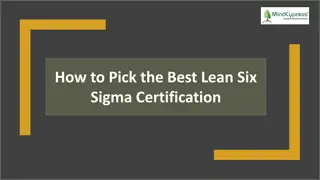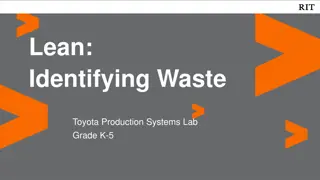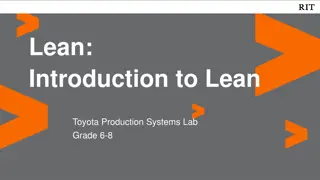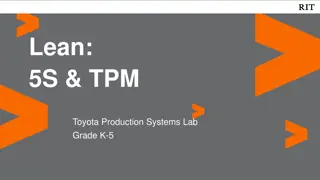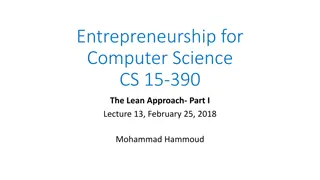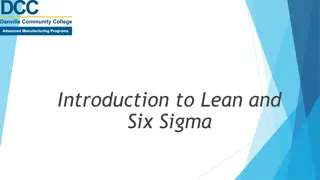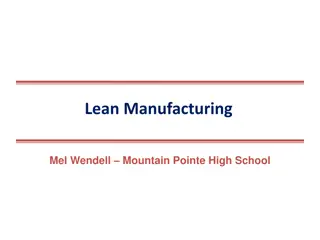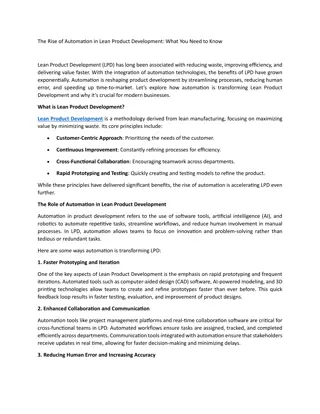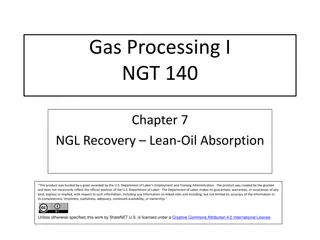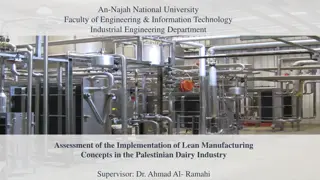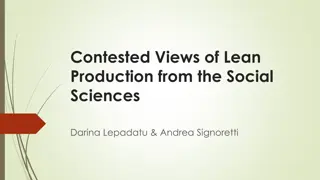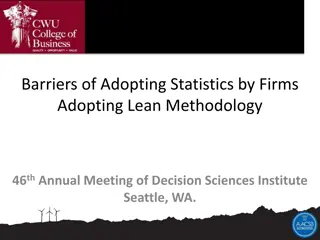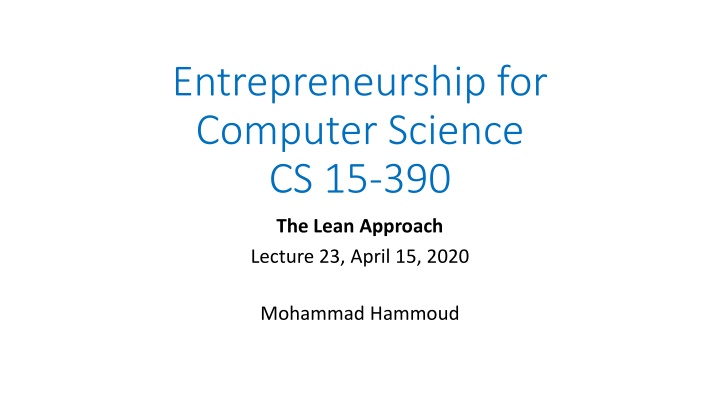
Lean Approach to Entrepreneurship in Computer Science: Value Creation Strategies
Explore the principles of lean thinking and value creation in entrepreneurship for computer science. Understand the importance of aligning efforts with customer needs and learn how to implement the Build-Experiment-Learn feedback loop effectively to create successful products. Discover the concept of Minimum Viable Product (MVP) through examples like Dropbox.
Download Presentation

Please find below an Image/Link to download the presentation.
The content on the website is provided AS IS for your information and personal use only. It may not be sold, licensed, or shared on other websites without obtaining consent from the author. If you encounter any issues during the download, it is possible that the publisher has removed the file from their server.
You are allowed to download the files provided on this website for personal or commercial use, subject to the condition that they are used lawfully. All files are the property of their respective owners.
The content on the website is provided AS IS for your information and personal use only. It may not be sold, licensed, or shared on other websites without obtaining consent from the author.
E N D
Presentation Transcript
Entrepreneurship for Computer Science CS 15-390 The Lean Approach Lecture 23, April 15, 2020 Mohammad Hammoud
Today Last Session: Quiz 2 Today s Session: The Lean Approach Announcements: PS4 is due tomorrow by midnight Project s milestone 4 is due on April 18
Value vs. Waste Question: Which of our efforts are value-creating and which are wasteful? Lean thinking defines value-creation as providing benefits to the customers; anything else is a waste! But, how can you know whether you are providing benefits (i.e., creating value) to your potential customers? Note: True startup productivity CANNOT be measured in terms of how much you are building every day, but rather in terms of systematically figuring out the right thing to build every day
Towards Value Creation Success is not about delivering a product; success is about delivering a product (or a feature of a product) that customers will use The way to do this is to continuously align your efforts with your customer s real needs Note: This is not about asking your customers what they need because customers typically do not know what they need The Build-Experiment-Learn feedback loop allows you to discover your customers needs and methodically align with them
Build-Experiment-Learn Feedback Loop Idea Learn Build Data Product Experiment
Build-Experiment-Learn Feedback Loop Idea Learn Build The Build Phase Data Product Experiment
The Build Phase: MVP The build phase can be entered as quickly as possible with a Minimum Viable Product (MVP) A MVP ranges in complexity from extremely simple smoke tests (little more than an advertisement) to early prototypes Prototypes Smoke Tests A product with problems and missing features No product is built yet!
Example of MVP: Dropbox Dropbox is an easy-to-use file sharing (or synchronization) tool, which uses a push-based caching (or full replication) technique Push immediately to Dropbox service & all sharing devices
Example of MVP: Dropbox Dropbox requires integration with a variety of computer platforms and OSs: Windows, Macintosh, iPhone, Android, and so on It also necessitates deep distributed systems expertise (caching, replication, consistency, reliability, availability, etc.) To avoid the risk of waking up after years of development with a product that nobody wanted, Drew Houston (founder & CEO of Dropbox) did something unexpectedly easy He made a video!
Example of MVP: Dropbox The video was a 3-minute demonstration of the technology as it is meant to work It was narrated by Drew himself (it was really banal!) It targeted early adopters, who do not need a perfect solution to get intrigued Drew recounted: It drove hundreds of thousands of people to the website. Our beta waiting list went from 5000 people to 75000 people literally overnight. It totally blew us away. Today, Dropbox is worth more than $10 billion
The Build Phase: MVP Deciding how complex a MVP cannot be done formulaically It requires judgment! When in doubt, simplify Avoid overbuilding and overpromising Any additional work beyond what needs to get you starting the loop might be a waste MVP does not only speak to product design and technical questions, but also serves in testing fundamental business hypotheses It provides a needed dose of reality It often results in seemingly bad (but actually good!) news initially
Build-Experiment-Learn Feedback Loop Idea Learn Build Data Product Experiment The Experimentation Phase
Leap-of-Faith Assumptions The riskiest elements of a startup s plan (i.e., the parts on which everything depends) are called leap-of-faith assumptions E.g., What was the main leap-of-faith assumption of Dropbox? File synchronization is a problem Note: Most people do not know about a certain solution (or even a problem); but once they experience the solution, they cannot imagine how they ever lived without it!
Leap-of-Faith Assumptions The two most important assumptions of any startup are the value hypothesis and the growth hypothesis The value hypothesis: It tests whether the product is really delivering value to customers after they start using it A testing metric: retention rate The growth hypothesis: It tests how new customers will discover the product A testing metric: referral rate
Example: Facebook In 2004, Facebook had 150,000 registered users with very little revenue Yet, that summer they raised their first $500,000 in venture capital Less than a year later, they raised an additional $12.7 million How Facebook was able to raise so much money when its actual usage was small?
Example: Facebook To answer this question, it suffices to look at Facebook s value and growth hypotheses: Validated value hypothesis: More than half of the users came back to the site every single day Validated growth hypothesis: Facebook launched on Feb 4, 2004, and by the end of that month, almost of Harvard s undergraduates were using it (without spending a dollar on marketing or advertising!)
Experimenting: Aardvark Google excels at answering factual questions What is the tallest mountain in the world? Who was the twenty third president of United States? However, Google struggles with answering subjective questions What is a good place to go out with a friend after a football game in my city? Subjective questions are relatively easy for a person to answer Imagine being at a cocktail party surrounded by friends; how likely would it be to get a high-quality answer for a subjective question? Very high!
Experimenting: Aardvark To technically solve this problem, Max Ventilla and Damon Horowitz created a product called Aardvark Max and Damon built a very basic prototype with an instant messaging (IM) front-end and a human-driven back-end (NOT an AI-based engine) A customer can send Aardvark questions via IM Aardvark will tap into the customer s social network via seeking out to the customer s friends and friends-of-friends A question about restaurants in San Francisco should not be routed to someone in Seattle Once Aardvark gets a suitable answer, it reports back to the customer
Experimenting: Aardvark The technique used by Aardvark is called Wizard of Oz Testing I.e., Customers believe they are interacting with the actual product, but behind the scenes human beings are doing the actual work This basic technique simply allowed Max and Damon to test their value and growth hypotheses If the tough technical problems behind this artificial-intelligence-centric product can be solved, will people use and keep using it? Will people tell their friends about it? Aardvark was acquired for a reported $50 million by Google
A/B Testing Another famous experimentation technique is called A/B (or split) testing Different versions of a product (or feature) are offered to two different groups of customers at the same time Changes in behavior are observed between the two groups and inferences are made about the impact of the different versions If an extra feature does not change customer behavior, it gets questioned A/B testing allows you to refine your understanding of what customers want and do not want
Build-Experiment-Learn Feedback Loop Idea The Learning Phase Learn Build Data Product Experiment
The Learning Phase Question: What do you want to learn? You want to learn what customers really want, and NOT what they say they want or what you think they would want Building a MVP and experimenting with it allows collecting real data, which can reveal the current status (or baseline) of your company Without a clear-eyed picture of your company s baseline, you cannot begin to track your progress and tune/alter your startup s engine
The Learning Phase The baseline could be zero, but it will allow you to create the motivation, context, and space for more qualitative and/or quantitative research New ideas will be generated, which can be incorporated and tested again The process repeats until reaching a decision point: pivot or persevere For example, pivot can involve changing the: Product (e.g., zoom-in or zoom-out pivots) Customer segment Business model Engine of growth (e.g., paid, sticky, or viral)
Example: Votizen In 2009, David Binetti started Votizen, a specialized social network for verified voters to learn about political issues and take collective actions David built a MVP that costed over $1200 in ~3 months and launched it with an attempt to test 4 major leap-of-faith assumptions 1. Customers would be interested in Votizen and sign up Defined metric: registration rate 2. Votizen will be able to verify them as registered voters Defined metric: activation rate
Example: Votizen In 2009, David Binetti started Votizen, a specialized social network for verified voters to learn about political issues and take collective actions David built a MVP that costed over $1200 in ~3 months and launched it with an attempt to test 4 major leap-of-faith assumptions 3. Verified customers would engage over time Defined metric: retention rate 4. Engaged customers would invite friends to join them into civic causes Defined metric: referral rate
Example: Votizen Three months after launching, the results were very low Initial MVP Registration Rate 5% Activation Rate 17% Retention Rate Referral Rate Too Low Too Low David spent another $5000 optimizing and split testing the usability aspects of the platform
Example: Votizen Two months after these optimizations, the results improved Initial MVP After Optimization Registration Rate Activation Rate 5% 17% 17% 90% Retention Rate Too Low 5% Referral Rate Too Low 4% David knew he had to do more; hence, he talked to more customers, held focused group discussions, and did countless A/B experiments
Example: Votizen Three months later, the results nudged up only slightly After 1st Optimization 17% After 2nd Optimization 17% Registration Rate Activation Rate 90% 90% Retention Rate 5% 8% Referral Rate 4% 6% The platform was not living up to the growth model David has hoped for! Time to pivot or persevere
Example: Votizen David s direct contact with customers provided the following feedback: 1. I always wanted to get more involved; this makes it so much easier 2. The fact that you prove I m a voter matters 3. There s no one here. What s the point of coming back? David decided to undertake a zoom-in pivot, refocusing the platform on what previously was considered a feature of a larger whole Customers can contact elected representatives digitally Votizen translates that digital contact into old-fashioned printed letters and petitions, and mails them to representatives at Congress
Example: Votizen Four months later and another $30,000, the results improved Before Pivot 17% After Pivot 42% Registration Rate Activation Rate 90% 83% Retention Rate 8% 21% Referral Rate 6% 54% David was stuck in an age-old entrepreneurial trap- i.e., metrics and product were improving, but not fast enough!
Example: Votizen David decided to undertake a customer segment pivot, keeping the functionality of his platform the same but changing the audience focus He contacted large companies and professional fundraisers who have professional or business interests in political campaigning The companies seemed extremely eager and David quickly signed Letters-of- Intent (LoI) to build the functionality they needed On the basis of LoI, David increased his head count and built all the required functionality in 3 months David went back to the companies, but none of them closed a real sale!
Example: Votizen David decided to fire some staff and undertake a business-model pivot, allowing anyone to become a paid customer with just a credit card and rally any group of people One month later, metrics started increasing Before 2nd Pivot 42% After 2nd Pivot 51% Registration Rate Activation Rate 83% 92% Retention Rate 21% 28% Referral Rate 54% 64%
Example: Votizen Votizen s system can now process voter identities in real time for > 47 states and has delivered 10s of thousands of messages to Congress The Startup Visa campaign used Votizen s tools to introduce the Startup Visa Act (S.565) This was the first legislation introduced into the USA Senate solely as a result of social lobbying On January 10, 2013, Votizen was acquired by Causes, an online civic engagement platform founded by Sean Parker
Next Lecture Final project presentations


